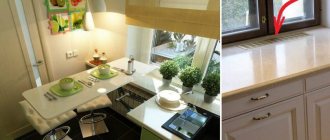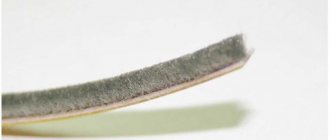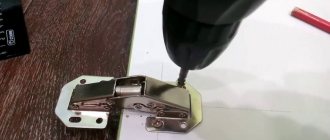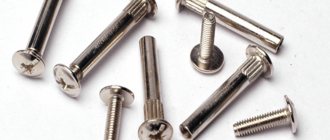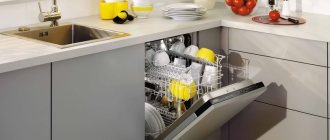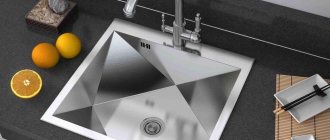Purpose and principle of operation of the device
An exhaust fan circulates air in the room.
It absorbs unpleasant and heavy air, and emits purified and fresh air. Each apartment has holes in the wall that lead to the general ventilation duct of the house. But over time, such air vents become clogged, their power weakens, and therefore the process of absorption of foreign particles in the air slows down. An exhaust fan improves the air exchange process.
The kitchen fan is a compact device with blades. The device operates after being connected to the mains. Starting to actively rotate, the blades draw in the “waste” air from the kitchen, push it through the device and push it out. The system of many fan models prevents the return of such air thanks to a special valve.
A kitchen exhaust fan can be installed in a kitchen that already has a hood above the stove. Working in tandem, these two devices will enhance each other's effectiveness.
Benefits of a silent design
The fans are precisely designed to achieve silent operation. As a result, the system offers the following additional benefits:
- minimal energy consumption;
- long service life;
- stepless speed control;
- high air suction efficiency;
Thanks to its smart design and silent operation, the silent fan can be installed in a room or bedroom, not to mention commercial and industrial areas.
Types of kitchen exhaust fans
Almost all models of exhaust fans that are on sale have a similar configuration, represented by a rotor and blades. And yet there are some differences.
Types of fans by type of rotor and blades
The following types of devices are distinguished:
- Axial or axial. With this design, the blades are located around an axis, and they rotate along its circumference. These fan models have the simplest design and are most common in houses and apartments.
- Centrifugal or radial. The difference between such fans is that the blades on the rotor are arranged in a spiral. This facilitates the capture of air along a trajectory corresponding to the blades, which significantly increases the power of such devices. This is why radial exhaust fans are used in industrial kitchens.
- Diametral (second name: “Squirrel Cage”). This type of fan has an oblong cylindrical shape, and its walls are long blades curved inward. The working process is that, while rotating, the rotor helps the blades capture air and push it deep into the ventilation duct. This type of exhaust fan is used for professional kitchens.
Types of fans according to installation location
According to this criterion, they distinguish:
- Window fans. Such devices are mounted directly into a small window connector, which you cut out yourself. All fumes from the cooking process are discharged directly to the street.
- Wall-mounted. These types of kitchen fans can be installed on either an interior or exterior wall (i.e. a wall with a window). In the first case, the heavier air will be conducted into the ventilation shaft, and in the second - to the street.
- Ceiling. As a rule, such fans are built into a suspended ceiling, since there is a passage leading into the ventilation duct in the space between the ceiling slab and the canopy.
There is another type of kitchen fans, which is presented in the form of a chandelier. The blades work in a circle, thereby accelerating the air. Of course, such fans do not have high power, so it is advisable to use them in the dining room or above the dining area. Their use is more aimed at the aesthetics of the room.
Which one is best to choose?
There are many brands of hoods on the market - Hansa, Krona, Gefest, Elikor and many others. Existing models differ in design, size, operating principle and installation method. When deciding which hood is best for a particular kitchen, the following criteria are usually taken into account:
- Type of exhaust system - recirculation, flow (direct-flow) or combined (can work as a recirculation or direct-flow system);
- Its appearance - how well it fits into the overall design of the kitchen;
- the material used - this affects both the appearance of the device and its durability;
- technical characteristics, such as the power of the device and the noise level it produces during operation;
- Dimensions – It is recommended that the system neck be no larger than the surface of the cooktop and that the ducts fit into existing vents
- the installation method, on which the installation of the hood largely depends - there are suspended, built-in, corner, telescopic and island models that can be mounted in various ways.
Fume hoods come with push-button, mechanical and touch controls. The different types of control do not provide any benefit; the choice is a matter of personal preference.
Device selection criteria
A responsible approach to choosing an air purifying device for the kitchen guarantees a comfortable stay in the kitchen during its operation. When choosing a kitchen exhaust fan, you should pay attention to:
Fan power
This parameter is taken into account based on the area of the kitchen. The larger the room, the higher the performance of the device should be. And vice versa - for a small kitchen, a low fan power will be enough.
In order to accurately calculate the device performance required for your kitchen, use a special formula: the volume of the kitchen (without taking into account the furniture located in it) is multiplied by a factor of 10.
So, for example, for a modest kitchen of 7 square meters. m, a fan with a power rating of 140-200 cubic meters is quite suitable. m/hour.
Fan design according to installation
In other words, if you intend to build an exhaust device into a wall or an exhaust duct in a wall, then you need to purchase a model for wall mounting. Similarly: for installation on the ceiling - a fan for ceiling installation, for window installation - the appropriate model.
Noise effect
The operation of the fan is accompanied by the emission of characteristic noise, and this is worth taking into account. It is recommended not to buy models that produce sound with an intensity of more than 40 decibels. Accordingly, the lower the noise level, the less noticeable the exhaust fan will be during operation.
Presence of a check valve
This criterion should be taken into account when it comes to choosing a wall or window fan. The presence of a valve will help prevent the penetration of foreign odors from the ventilation duct or the street.
Resistance to high moisture and temperature changes
These criteria are relevant for a kitchen fan, since temperature changes and condensation constantly occur in the kitchen area.
Fan dimensions
The purchased device must not only fit perfectly into its installation location, but also cover the boundaries of the old frame from the ventilation duct.
Control type
According to this criterion, fans with automatic control and mechanical control are distinguished.
The first option is the most convenient. It is equipped with motion sensors, sensors for temperature and moisture changes and, depending on the indicators of these parameters, changes the intensity of its work or turns off completely. Controlled using a remote control.
The second type - the fan is turned on/off using the power cord or using a separate switch.
Design
The appearance of the exhaust fan should fit into the overall interior of the kitchen.
Functional
We have already discussed in more or less detail the types of silent exhaust fans, and now let’s move directly to the characteristics and various functions. Good brands will quickly help provide effective forced ventilation. Very useful is the operation of the check valve, which protects the internal space from air masses from the outside.
There are several types of dampers: the passive type operates only when the impeller is activated, the automatic type has a manual opening and closing system, and the self-closing type is activated by a specialized spring.
By the way, sometimes it is not included in the model at all, which usually indicates its cheapness. It is very important that moist air comes out and clean air comes in.
You can make a choice in one direction or another. The modification features are not very critical. The buyer himself decides what he needs. Passive ones almost never break down, while electric ones are more convenient and comfortable to use. Malfunctions happen, but they are not fatal.
The best models of exhaust fans for the kitchen
Exhaust fans differ in many parameters, including cost. In terms of choice, it is of no small importance; moreover, among the budget options you can find quite decent exhaust fans.
Below we will present several models of popular exhaust fans. Their merits are appreciated by many buyers, whose reviews recommend them for purchase.
ERA D 100 (PROFIT 4 12V)
Budget hood for a small kitchen. Its cost is 500-550 rubles in specialized stores.
"Era" D 100 is a representative of an axial exhaust fan that fits perfectly into the ventilation duct connector. The body is made of durable plastic, which is protected from fading in the sun. The rotor does not overheat and is protected from condensation.
The emitted noise level does not exceed 35 dB.
Planet Perfecto 100K with check valve
This is another option for a budget fan, the price tag of which varies between 600-700 rubles. The device is a typical representative of an axial fan, the rotor of which is equipped with a check valve. This is very convenient for the kitchen, because after turning off the fan, the unpleasant smell does not return to the room.
The power of the device is 14 W, which is quite suitable for a small kitchen. In addition, the acoustic pressure of “Planet Perfecto 100K” does not exceed normal levels - 39 dB.
DICITI D 100 (PARUS 4C)
The exhaust fan, original in its design (available in several colors), is made of durable ABS plastic, which protects the device from thermal changes, increased moisture and fading.
The manufacturer guarantees 40,000 hours of continuous fan operation, which is made possible thanks to the 16 W motor power. The level of noise waves does not exceed 35 dB. The fan reliably holds the absorbed air, preventing it from escaping back.
The cost of the Parus 4C device is 980 rubles.
Fan Vents TT PRO 200
This exhaust hood will cost 4,000 rubles, but will do its job perfectly.
It is recommended to use it in the kitchen, where there is high humidity and frequent temperature changes. The case is made of high-quality, durable plastic, which protects the internal “filling” of the device. The latter is represented by a rotor and a terminal box, which are secured with clamps.
Maximum power – 108 W. Acoustic pressure – 45 dB.
Installing a fan in the kitchen: step-by-step instructions, tips
The installation of window and wall fans differs from each other. The first option is easier to install, regardless of weather conditions and renovations in the apartment. But the wall-mounted device will have to be combined with the general remodeling of the room, and also provide for a few more nuances.
Window fan installation
Step by step guide:
- As a rule, in typical apartments the kitchen area is equipped with one window. If there are several of them, then the fan needs to be built into what is located closer to the cooking area - to the stove.
- The height for installation is chosen as high as possible, but so that at least 20 cm remains to the edge of the window glass.
- Measure the fan parameters (length and width) without violating the boundaries of the casing, and according to the measurements, cut out a connector in the window glass with a glass cutter.
- Rubber tabs are installed on the fan casing, which will facilitate better fixation of the device on the window. After this, the fan is placed in the prepared connector.
- A rotor with blades is placed in the casing so that the edges of the blades do not touch the walls.
- After these manipulations, the fan is connected to the electrical network and the correct installation is checked. If everything works, then proceed to install the protective grille.
Installation of a wall-mounted exhaust fan
The installation steps described below are suitable for installing the fan on both the external and external (window) walls. The only difference is that when installing a fan on an external wall, it is covered with grilles not only inside the room, but also outside.
Step by step guide:
- Before installing a wall-mounted kitchen fan, you need to prepare the ventilation duct. If necessary, it is cleaned. If the house has just been put into operation, this may not be required.
- Most often, the ventilation duct has access to the kitchen in the form of an opening covered with a grill. It needs to be removed. If the hole in the wall is not suitable for installing a fan, it must be widened. To do this, use a concrete hammer drill.
- After this, a small piece of pipe is installed in the hole, and then the ventilation device itself.
- At the end of installation, check the operation of the device by connecting it to the power supply. If everything works properly, then install a protective surface grille.
A kitchen exhaust fan for the kitchen is a necessary device, especially if the kitchen is small and installing a hood in it is inappropriate or an addition to the installed hood is necessary. A fan will make your stay in the kitchen more comfortable, as it will absorb all fumes and odors and release fresh and pleasant air.
Air exchange in rooms
For a long time, the use of natural ventilation was considered the most optimal way to ensure air exchange. Until now, most houses use precisely this principle, since the system is characterized by simplicity of design and does not require energy to move air volumes.
The air exchange system solves a number of important problems:
- supply of fresh atmospheric air;
- removal of products of incomplete combustion of household gas;
- elimination of unpleasant odors;
- removal of carbon dioxide;
- reduction of indoor temperature;
- Humidity regulation.
The movement of street air into rooms occurs due to the difference in pressure in the rooms and outside the house. When the windows are open, the movement of air masses increases significantly - this is how ventilation occurs.
Natural ventilation was developed through the widespread use of windows with wooden frames. The window openings had a sufficient number of slots to ensure a change in the required air volumes. The situation became significantly more complicated with the advent and widespread use of double-glazed windows, the design of which provides for the use of highly effective seals. Once the window opening has become sealed, it no longer allows outside air to pass through, which can completely disrupt the operation of the ventilation.
More expensive models of modern windows are equipped with special valves for ventilation. However, the cost of such designs encourages buyers to abandon advanced models and give preference to cheaper ones.
As a result, the first to suffer are the rooms in which ventilation outlets are located according to the project:
- Kitchen. It is especially important here to remove household gas combustion products if the house is gasified. The health and safety of a person’s stay indoors during the cooking process depends on this. The operation of the four burners of a gas stove requires the exchange of at least ninety cubic meters of air per hour. An exhaust fan cannot always cope with this volume, but properly selected exhaust ventilation will certainly solve the problem.
- Bathroom. Using large volumes of water creates increased humidity. Ineffective ventilation not only reduces the usability of the bathroom, but also contributes to the appearance of mold, which actively multiplies in a warm and humid environment.
- Toilet. This requires increased air exchange to ensure freshness.
In addition, good operation of ventilation ducts ensures the removal of air from living rooms, since street air masses first pass through them, and only then enter the air ducts of the kitchen, bathroom and toilet.
There is another problem that negatively affects air exchange. Over a long period of operation, ventilation ducts accumulate on their walls a significant amount of grease, dust, soot and other contaminants. The nearest air duct outlet in the apartment can be cleaned yourself, but the vertical ducts are inaccessible.
We recommend that you read: Adjustable ventilation grilles
In addition, residents do not have the right to maintain them themselves—cleaning can only be done by an organization entrusted with the operation of the building. Many companies ignore this issue, which is why ventilation ducts remain uncleaned for decades. As a result, you can often encounter difficulty in air removal even with the windows open.
The problem of poor quality air exchange can be solved by switching to forced ventilation. The easiest way is to install conventional fans in the standard air duct openings.
